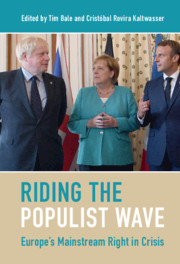Book contents
- Riding the Populist Wave
- Riding the Populist Wave
- Copyright page
- Contents
- Contributors
- Figures and Tables
- Preface
- 1 The Mainstream Right in Western Europe: Caught between the Silent Revolution and Silent Counter-Revolution
- 2 The Demand Side: Profiling the Electorate of the Mainstream Right in Western Europe since the 2000s
- 3 The Supply Side: Mainstream Right Party Policy Positions in a Changing Political Space in Western Europe
- 4 Austria: Tracing the Christian Democrats’ Adaptation to the Silent Counter-Revolution
- 5 France: Party System Change and the Demise of the Post-Gaullist Right
- 6 Germany: How the Christian Democrats Manage to Adapt to the Silent Counter-Revolution
- 7 Italy: The Mainstream Right and its Allies, 1994–2018
- 8 The Netherlands: How the Mainstream Right Normalized the Silent Counter-Revolution
- 9 Spain: The Development and Decline of the Popular Party
- 10 Sweden: The Difficult Adaptation of the Moderates to the Silent Counter-Revolution
- 11 The United Kingdom: The Conservatives and their Competitors in the post-Thatcher Era
- 12 The Mainstream Right in Western Europe in the Twenty-First Century
- References
- Index
11 - The United Kingdom: The Conservatives and their Competitors in the post-Thatcher Era
Published online by Cambridge University Press: 13 August 2021
- Riding the Populist Wave
- Riding the Populist Wave
- Copyright page
- Contents
- Contributors
- Figures and Tables
- Preface
- 1 The Mainstream Right in Western Europe: Caught between the Silent Revolution and Silent Counter-Revolution
- 2 The Demand Side: Profiling the Electorate of the Mainstream Right in Western Europe since the 2000s
- 3 The Supply Side: Mainstream Right Party Policy Positions in a Changing Political Space in Western Europe
- 4 Austria: Tracing the Christian Democrats’ Adaptation to the Silent Counter-Revolution
- 5 France: Party System Change and the Demise of the Post-Gaullist Right
- 6 Germany: How the Christian Democrats Manage to Adapt to the Silent Counter-Revolution
- 7 Italy: The Mainstream Right and its Allies, 1994–2018
- 8 The Netherlands: How the Mainstream Right Normalized the Silent Counter-Revolution
- 9 Spain: The Development and Decline of the Popular Party
- 10 Sweden: The Difficult Adaptation of the Moderates to the Silent Counter-Revolution
- 11 The United Kingdom: The Conservatives and their Competitors in the post-Thatcher Era
- 12 The Mainstream Right in Western Europe in the Twenty-First Century
- References
- Index
Summary
After the end of the premiership of Margaret Thatcher in 1990, the Conservatives struggled to regain the hegemonic position they enjoyed under her leadership, having to wait until 2019 to once again win a general election with a convincing majority. This chapter analyses these travails in relation to the silent revolution and the silent counter-revolution. As a classic catch-all party, the Conservatives have had to battle to hold together a sufficiently broad electoral coalition, challenged in the political centre by the Liberal Democrats and (for a time) New Labour, and on the right by Eurosceptic populists in the UK Independence Party (UKIP) and more recently the Brexit Party. As the chapter explores, the Conservatives in opposition after the 1997 general election responded initially to the silent counter-revolution, attempting to shore-up their support on the right. Ongoing electoral defeat saw the party under David Cameron embrace the process of value change identified in Inglehart’s ‘silent revolution’ thesis. In more recent years, the Conservatives have sought once again to contain, and arguably have embraced, the silent counter-revolution of the populist radical right.
- Type
- Chapter
- Information
- Riding the Populist WaveEurope's Mainstream Right in Crisis, pp. 269 - 289Publisher: Cambridge University PressPrint publication year: 2021
- 3
- Cited by



